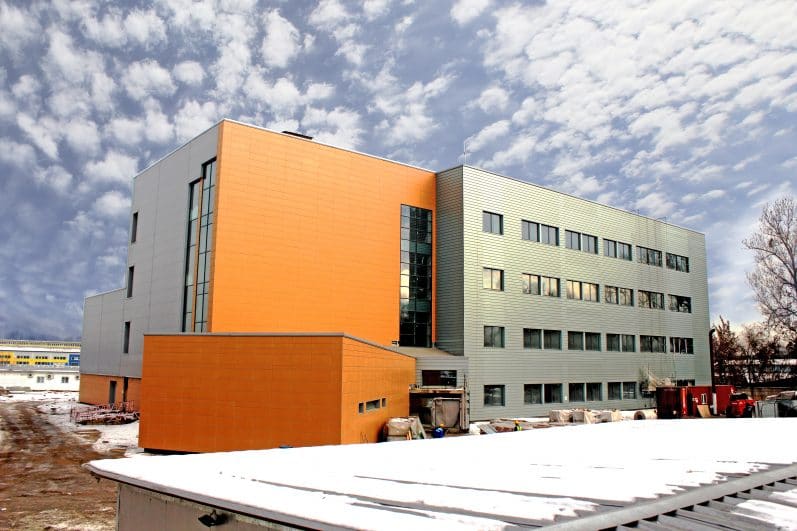
September 2017
In a dusty suburb near Almaty, Kazakhstan, where the Soviet-era buildings still hint at a different time, a slice of high-tech modernity has arrived—in the form of a $102 million biosecurity laboratory.
The Central Reference Laboratory (CRL) will open in 2015 and offer high-security lab space for scientists to study dangerous diseases and provide early warning of potential outbreaks. (Read about the global war on disease.)
The facility, funded by the United States Defense Threat Reduction Agency (DTRA) and the Nunn-Lugar Cooperative Threat Reduction Program, will have the additional benefit of giving stable employment to scientists who might otherwise be tempted to sell their high-level and potentially destructive knowledge to hostile groups, said Lt. Col. Charles Carlton, director of the DTRA offices in Kazakhstan.
The facility will also be a secure place to archive existing disease strains. The threat of theft is real: In 2002, for example, authorities arrested a man who entered a biodefense facility near Almaty, apparently intending to steal the pathogens inside, according to a paper from the United States Institute of Peace.
In September 2017, the construction of the Central Reference Laboratory (CRL) was completed. The laboratory was built and equipped with US funds under the Cooperative Threat Reduction Program. The CRL project, starting from the sketch, load-bearing structures, explication of premises, communications and life support systems, went through a full cycle of expertise at the level of the State Architectural and Construction Committee of Almaty, approved by the Ministries of Health, Agriculture, Education and Science of the Republic of Kazakhstan.
The Agency has just under two dozen offices and facilities scattered around the world to keep an eye out for would-be biological weapons, including in Georgia (the Caucasus rather than deep South one), Armenia, Ukraine, Uzbekistan, Azerbaijan and Russia. Before the USSR broke up, the Soviets were known to have weaponized plague and were tinkering with other potential biological weapons, though what became of those deadly cultures remains unclear. As such, biological weapons expert Raymond Zilinskas told NatGeo, “There’s a real biosecurity threat in countries of the former Soviet Union, and the Russian government is remarkably uncooperative in this area.”
Published DTRA locations in 2013 were:
UNITED STATES
- National Capital Region
- Aberdeen, Md.
- Eglin Air Force Base, Fla.
- Omaha, Neb. (USSTRATCOM)
- Albuquerque, N.M.
- White Sands Missile Range, N.M.
- Mercury, Nev.
- Travis Air Force Base, Ca.
- Honolulu, Hawaii
OTHER COUNTRIES
- London, United Kingdom
- Kaiserslautern, Germany
- Kiev, Ukraine
- Moscow, Russia
- Tbilisi, Georgia
- Yerevan, Armenia
- Baku, Azerbaijan
- Astana, Kazakhstan
- Tashkent, Uzbekistan
- United States Forces Korea, Republic of Korea
- Yokota, Japan
- Singapore
On March 26, 2015, Kenya was on this list as well. The first archive showing Kenya is August 13, 2014.
Sources:
- September 24, 2013. Jillian Keenan. “New High-Tech Laboratory in Kazakhstan to Fight Plague Outbreaks.” Culture.

https://www.nationalgeographic.com/culture/article/new-high-tech-laboratory-in-kazakhstan-to-fight-plague-outbreaks.
General Website Link. - September 25, 2013. Rachel Nuwer. “This U.S.-Backed Lab Is Meant to Keep Talented Kazakh Scientists From Making Biological Weapons.” Smithsonian Magazine.

https://www.smithsonianmag.com/smart-news/this-us-backed-lab-is-meant-to-keep-talented-kazakh-scientists-from-making-biological-weapons-67188/.
General Website Link. - “История Центра [History of the Center].” National Scientific Center of Especially Dangerous Infections Named After Masgut Aikimbayev.

https://nscedi.kz/wp-content/themes/infection/materials/history/history-1.pdf.
PDF.
Related:
- April 29, 2018. Dilyana Gaytandzhieva. “The Pentagon Bio-Weapons.” Dilyana.Bg.

https://dilyana.bg/the-pentagon-bio-weapons/.
General Website Link. - March 17, 2022. Rhoda Wilson. “US Company Metabiota Links Biolabs in Africa and Ukraine to the Pentagon’s DTRA.” The Exposé.

https://expose-news.com/2022/03/17/metabiota-links-biolabs-to-the-pentagons-dtra/.
News. - May 13, 2022. John Wanjohi. “Russia Raises Questions About a US-Funded Biolab in Kenya.” Mwakilishi.Com.

https://www.mwakilishi.com/article/kenya-news/2022-05-13/russia-raises-questions-about-a-us-funded-biolab-in-kenya.
General Website Link. - “DTRA Locations Around The World.” Defense Threat Reduction Agency & USSTRATCOM Center for Combating WMD. Archived February 13, 2013.

https://web.archive.org/web/20130213203238/http://dtra.mil/Info/Locations.aspx.
General Website Link. - “DTRA Locations Around The World.” Defense Threat Reduction Agency & USSTRATCOM Center for Combating WMD. Archived August 13, 2014.

https://web.archive.org/web/20140813202305/http://www.dtra.mil/Info/Locations.aspx.
General Website Link. - “DTRA Locations Around The World.” Defense Threat Reduction Agency & USSTRATCOM Center for Combating WMD. Archived March 26, 2015.

https://web.archive.org/web/20150326190612/https://www.dtra.mil/Info/Locations.aspx.
General Website Link.